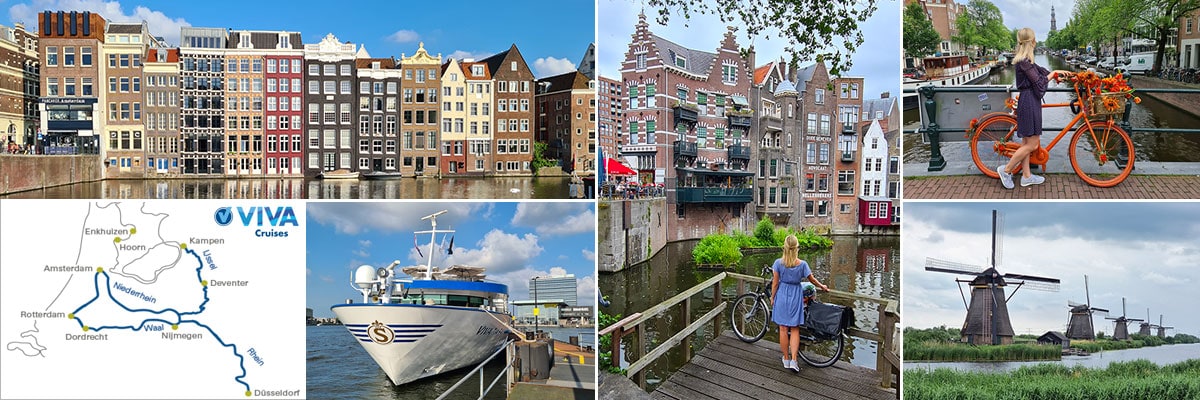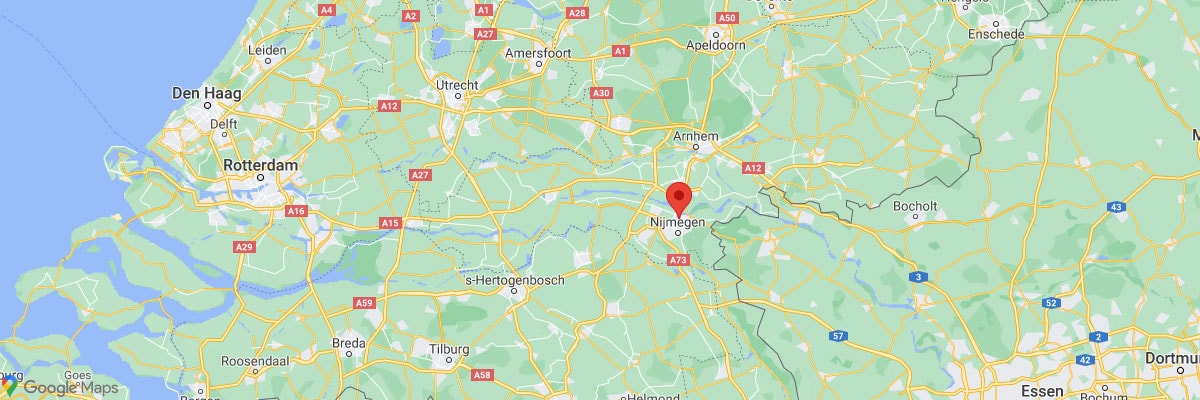The last stop of our river cruise with VIVA Cruises on the Rhine was the city of Nijmegen. The city on the banks of the Wall is characterized by a 2,000-year-old history and thus describes itself as “the oldest city in the Netherlands”. We find it interesting that the cities of Maastricht and Dordrecht also claim this title for themselves 🙂

Table of contents
Things to know about the city of Nijmegen
The former Hanseatic city of Nijmegen is located in the east of the Netherlands in the province of Gelderland and is only 5 km from the German border. With over 2,000 years of history, it describes itself as the oldest city in the country and has about 178,000 inhabitants.
As early as 104 AD, the Romans founded a settlement on the territory of today’s Netherlands with the name Noviomagus (“New Market”). During Roman domination, the city was part of the Limes and formed the border between the Roman Empire and the Germanic territories. Even after the departure of the Romans around the year 410, the importance of the city grew steadily into the Middle Ages. Charlemagne built a palatinate on the walls of the castle in 777 and Emperor Frederick Barbarossa had his Valkhof castle on the south bank of the Waal completed here in 1155. From 1230 Nijmegen was a free imperial city and in 1402 it became a member of the Hanseatic League.
During The Second World War, an Allied bombardment caused heavy destruction in the city. Nevertheless, some of the historically valuable buildings and squares have been preserved to this day. The city centre offers many shops, cafés, churches and historic buildings from the Middle Ages. Among the most famous sights are the Stevenskerk, the stadtwaage on the Großer Markt, the Valkhof with the Barbarossa ruins, the Kronenburgerpark and the oldest shopping street in Holland: the Lange Hezelstraat.
The landing stage of viva TIARA
With our cruise ship we have created centrally between the Waalbrücke and the Snelbinderbrücke. From here we only needed 5 minutes walk to Stevenskerk and downtown. Our layover time was from 2am to 2pm in the afternoon, so we had about 5 hours to visit the city after breakfast.
Discover VIVA CRUISES at e-hoi
The sights of Nijmegen
The main attractions in Nijmegen are all very centrally located and therefore easy to explore on foot and on your own.
Around the Grote Markt
Our first point of contact was the Grote Markt. The central market square is located in the historic core of the city.
Around the market square there are now seven cultural monuments (Rijksmonumente) such as the Boterwaag (stadtwaage), the Sint-Stevenspoortje (the Stephanstor) and various residential buildings. In addition, the Grote Markt is home to the most important shopping streets, such as the Broerstraat or the Lange Hezelstraat.
The Boterwaag is a scale house built in 1612/1613 in Renaissance brick style and restored in 1886. The city scale was located on the western side of the building with a meat market hall on the ground floor. Also on the market square is the St. Stefanstor, through whose wide passage the church visitors could reach directly from the Groten Markt to the Stevenskerk.
At the Grote Markt, the two shopping streets Burchtstraat and Heezelstraat meet, which is considered the oldest shopping street in the Netherlands.
The Stevenskerk
The construction of the Stevenskerk or Grote Kerk (“Great Church”) began around the middle of the 13th century. The Stevenskerk was built on the then almost undeveloped Hundisburg and has shaped the image of the city ever since.
In 1273, the church was consecrated by the Bishop of Cologne (Albertus Magnus), of whom a relic can still be seen in the funerary chapel. In the course of the 15. and In the 16th century, the choir, chapels and parts of the nave were rebuilt. After its destruction in the Second World War, the church was thoroughly restored and solemnly reopened in 1969.
We only took a quick look at the church, but we didn’t find it really beautiful. However, it is worth exploring the small paths around the church. Here is e.B. the former Kanunnikenhuis. In 1469, after her death, Duchess Catherine of Bourbon left a large sum of money to elevate St. Stephen’s Church to the rank of a collegiate church. The church received a Christian board of directors of about thirty canons who were responsible for the administration of the church. They lived in a row of houses on the north side of the church in the so-called canon houses at Stevenskerkhof.
Der Kronenburgerpark
In any case, we can recommend a short walk through the Kronenburgerpark. The beautifully landscaped park is located in the center of the city and you can still find some remains of the medieval city wall and the Kruittoren (Powder Tower). In Kronenburgerpark there is also the stone statue of a lion, which was donated in 1886 by the Nijmegen Beautification Association and is now a listed building.
The Valkhof & the Hunnerpark
The Valkhof is located in a park above the Waal and is the ruin of a palace that was begun by Charlemagne in the 8th century and continued by Emperor Frederick Barbarossa from 1155. Except for two side chapels, the entire complex was destroyed in 1796. On an old oil painting by Lieve Verschuier from 1670 you can still see very well how imposing the palace must have been in its time.
A walk through the park is worthwhile, because there is a lot to discover here. On the one hand, there is the St. Nicholas Chapel (Valkhof Chapel), one of the original two chapels of Valkhof Castle. It is one of the oldest buildings in the Netherlands and the oldest preserved part of the Palatinate complex of Nijmegen. From the chapel you also have a great view of the Waal and the region. Not far from St. Nicholas Chapel are the Barbarossa ruins, the remains of St. Martin’s Chapel.
At the northern end of Valkhofpark is the Museum De Bastei, which opened in May 2018. The museum tells the story of the connection between the city of Nijmegen and the Waal River over time: from the origin of the landscape to the present.
Directly to the Valkhofpark is the Hunnerpark in the west. Here is the Belvédère, a watchtower built in the middle of the 15th century. Today, the building functions as an event location.
A walk on the banks of the Waal
Before we went back on our river cruise ship, we took a short walk on the banks of the Waal. Here you will find e.B the National Bicycle Museum, the Holland Casino, the Het Labyrinth and the Lindenberghaven.
Due to time constraints, we unfortunately did not manage to visit the statue “The Face of Nijmegen” (Het Gezicht van Nijmegen) on the opposite bank of the Waal.
More Sights & Photo spots
On our tour through the city of Nijmegen we were able to discover numerous other sights & photo spots, such as the historic town hall (Stadhuis). This was built in 1554/1555 in the style of the early Renaissance and today houses a variety of historical and modern works of art as well as a torture chamber in the medieval vault.
Not far from the old town hall is the national monument Arsenal. The building was built between 1820 and 1824 as an artillery house on the site of the former mariënburg monastery complex, which also included the Marienburg chapel opposite. Today, the Marienburg houses the Museum Huis van de Nijmeegse Geschiedenis (“House of the History of Nijmegen”).
Another photo spot is the “De Sint-Jacobskapel of Glashuis” west of the Stevenskerk. The brick chapel was built in the fifteenth century as part of the St. Jacobsgasthuis.
A map with all the sights in Nijmegen
On the following map at Google MyMaps we have marked all important sights & photo spots in Nijmegen from this travelogue.
All travel reports of our river cruise on the Rhine
For one week we were on the Rhine with VIVA TIARA from Düsseldorf and got to know some of the most beautiful places in the Netherlands. From the pretty harbor towns of Deventer and Kampen, we continued to Enkhuizen and Hoorn, where we crossed the largest lake in the Netherlands - the Ijsselmeer. From here, our ship took us to the two metropolises of Amsterdam and Rotterdam, on to Dordrecht and the world-famous windmills of Kinderdijk, and finally to the city of Nijmegen. » VIVA Cruises - Our cruise ship VIVA TIARA
» VIVA Cruises - Our cruise ship VIVA TIARA» Deventer - Sights & Photo Spots of the Hanseatic City
» Kampen - Things to do in the former Hanseatic City
» Enkhuizen - Historic harbor town on the IJsselmeer
» Hoorn - Things to do in the historic town
» Amsterdam - The most beautiful photo spots & sights
» Rotterdam - The most beautiful sights & photo spots
» Dordrecht - Sights & our walking tour in the city
» Kinderdijk - The 19 windmills of Kinderdijk in Holland (UNESCO)
» Nijmegen - Sights of the oldest city in the Netherlands
» Düsseldorf - Sights & the most beautiful photo spots





